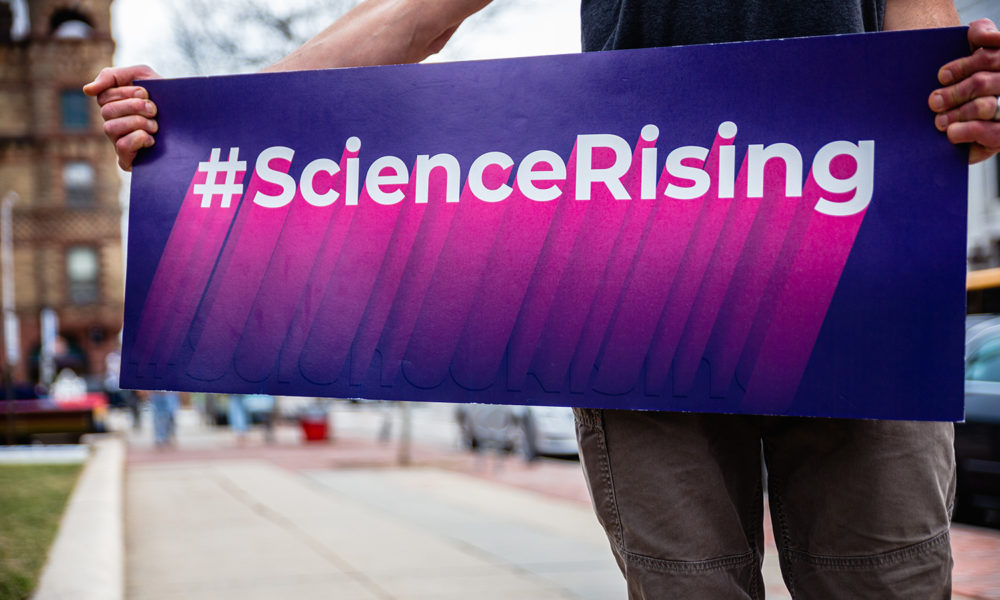Back in January 2020, the scientific community (like much of the country) was gearing up for “the most important election of our lifetime.” Building off the successes from the 2018 midterms, Science Rising was ready to mobilize people to fight for science, equity, and justice by focusing on increasing STEM student voter turnout. Of course, civic engagement and voter turnout this year looked much different than we were envisioning. But our network of science organizations and students across the country embraced new and creative ways to make sure that their communities and campuses were registered, had the information they needed in order to vote safely, and were able to turn out in record numbers across the country.
From writing op-eds about the intersection of science and justice, to virtual debate watch parties, to training STEM students on voter registration, it has been inspiring to see how many people have stepped up to prove that science IS rising, and that science is an integral part of our democracy. Here is how students, scientists, and science supporters around the country chose to “rise and science” in 2020:
We mobilized
- Through the Science Rising TurboVote tool, we assisted more than 2200 people with voter registration and requesting a mail-in ballot.
- In close collaboration SACNAS, we created the Science Rising Challenge to increase STEM voter registration and turnout. This Challenge outlines key actions for participating in our democracy, including registering and making a plan to vote (if eligible) and guidance on how to organize or complete other nonpartisan civic engagement activities. More than 75 people completed multiple challenge activities.
- Jointly with Scholars Strategy Network, we created a 3-part faculty guide to student voting for faculty to integrate voter registration and civic engagement into their classrooms.
We strengthened the science advocacy movement
- Our network was made up of 21 coalition and organizing partners who contributed to strategies and ideas for resources, and shared tools and messaging on how to safely get out the vote
- With Sister, we published 9 advocacy stories by women in STEM, in order to amplify new voices and build the narrative around what science advocacy looks like.
- We raised the profile of the issue of increasing STEM student voter turnout. This was not an issue getting traction before Science Rising came on the scene. Sonia Zarate, president of SACNAS and a key partner for the Science Rising Challenge, even brought it up in her introductory remarks for their national conference:
“Although science is bipartisan, communities are facing very real disproportionate threats as a result of the denial of climate science, the dismantling of government institutions and policies that uphold scientific principles, and the outright attack on the identities that make up our membership. To put it bluntly, the future of STEM hangs in the balance of this election. Historically, STEM majors have been the least likely to vote. But that must stop right now. If you have the right to vote, it is your responsibility as a scientist to do so. With the election only two weeks away, we must each commit to make our voices heard through our votes, and if need be, through dissent.”
We supported people in engaging their communities and campuses
Through the Science Rising Challenge Fund, we funded 23 projects with more than $17,000 to support groups who share our mission of fighting for science, equity, and justice in our democracy leading up to the election. Here are just a few examples:
- March for Science NYC launched an online panel series and voter registration campaign that focused on local science policy issues.
- The Massachusetts Science Policy Network created a voter information toolkit for the City of Worcester, and printed voter information in English and Spanish to be distributed by local businesses.
- The Puerto Rico Science Policy Action Network (PR-SPAN) launched the initiative “Visibilidad y conCiencia de cara a las elecciones 2020” to bring visibility about the importance of science in emergency management, as well as its role in education, technology, agriculture, and Puerto Rico’s overall wellbeing.
- In coordination with the National Science Policy Network’s 2020 Election Initiative, more than 15 graduate students published op-eds about important science policy topics to raise awareness from local, state, and federal candidates leading up to the election.
- Overall, Science Rising supported and amplified 124 events and activities that mobilized students and science advocates around civic engagement efforts, and trained more than 450 individuals on voter registration and engagement tactics
Ultimately, Science Rising built power within the science advocacy movement—and the level of engagement from partners, supporters, STEM students, and the broader STEM community suggests that we drove home the narrative that participating in our democracy is critical for both scientists and science. During a tough election and an even tougher year, it was rewarding to see people rallying behind participating in our democracy, despite the obstacles.
What’s next?
Thanks to the support, energy, and ingenuity of our partners, grant recipients, participating organizations, and individuals around the country, we can confidently say we made valuable contributions to increasing STEM voter turnout and civic engagement within the science community in the 2020 election—and we’re proud of it!
We’re taking a pause to recharge after all that 2020 threw at us, and to reflect on what the future looks like for Science Rising. If you’d like to be part of that conversation, you can reach out to Melissa Varga at partnerships@sciencerising.org, or follow our updates on @SciRising on Twitter, or on our website.
In 2020, we were able to keep up the momentum and continue to build the culture of advocacy and civic engagement within the science community—but we still have a long way to go. I hope you’ll stick with us as we keep pushing for science, equity, and justice in our democracy not just in election years, but every year and in every community across the country.

